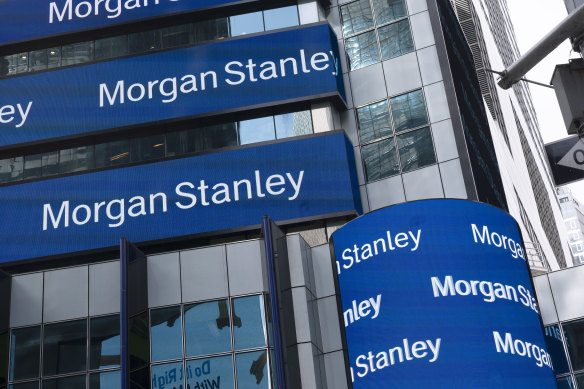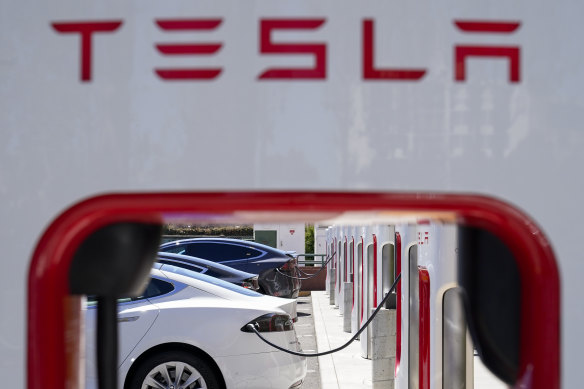
The $US1.5 trillion leveraged loan market that has been a key source of funding for leveraged deals like Musk’s and which has provided the core of the debt funding for private equity transactions, including some Australian deals, has almost completely dried up.
Issues of leveraged loans in the September quarter fell to their lowest levels since the financial crisis of 2008-09 and there has been a significant increase in the rate of defaults on those loans. In August alone there were $US6 billion of defaults, the biggest number since the early phase of the pandemic.
The major US banks have already started reporting material losses on their leveraged loan exposures, with Citi, Wells Fargo, JP Morgan Chase and Bank of America, among others with smaller exposures, disclosing September quarter losses totalling about $US1 billion during their recent reporting season.

Financial giant Morgan Stanley is one of the banks facing heavy losses on their loans.Credit:AP
To date, there have been more than $US22 billion of leveraged loan defaults this year, or about three times the level experienced in the same period of last year. In the past three months there have been about $US12 billion of defaults.
There are forecasts from those close to the market that the value of the defaults could triple within six months and more than quadruple within a year as the magnitude of the surge in interest rates stymies the ability of leveraged companies to refinance but, of more immediate significance for the Twitter deal than the rate of losses is the effective closure of a market the big commercial banks have relied on to syndicate their riskier loans.
Loading
Morgan Stanley, Bank of America and Barclays are Musk’s key bank bankers, along with Societe Generale (historically very active in providing leveraged finance for private equity deals in the Australian market), BNP Paribas and Japan’s Mizuho and MUFG (Mitsubishi UFG Financial Group).
It is conceivable, if they were prepared to take the $US500 million-plus “hair cut,” that they could sell down their exposure to Twitter by on-selling the debt at a big discount to its face value.
The alternative is for them to retain the exposure on their balance sheets through to maturity (or default) and hold expensive capital against it.
Confronted with similar predicaments this year, other banks (and Bank of America) have chosen to take their medicine and dump their debt.
Bankers who provided the $US15 billion of debt funding for the leveraged buyout of US software group Citrix Systems on-sold some of their bonds and leveraged loans at big discounts to their face value earlier this year. The sales, at an effective yield of about 10 per cent, crystallised losses for the consortium of about $US600 million. The banks were forced to retain about $US6.5 billion of the debt on their own balance sheets.

Tesla shares have crumbled since Musk began his Twitter chase, wiping billions off his net worth. Credit:AP
Another banking syndicate recently ditched plans to syndicate $US3.9 billion of the debt they had committed to the purchase of Lumen Technologies by Apollo Global Management because of the lack of interest from investors.
With interest rates still rising and economic conditions worsening– a US recession appears increasingly likely – the environment for syndications, which was booming at the start of the year before the Fed started hiking rates and before Russia invaded Ukraine, has deteriorated since those deals flopped.
If the Twitter deal looks likely to be a bust for the lenders, spare a thought for Musk himself.
The equity component of the offer is about $US33.5 billion, of which about $US7 billion has been lined up from third parties. Unless he can solicit some more third-party equity, the rest has to be provided by Musk himself. He had a pre-existing stake worth about $US4 billion at the bid price and has since sold more than $US15 billion of his Tesla shares to help fund the bid.
Given what’s happened in equity markets since the big price was set, that Twitter equity will be worth something considerably less than $US33.5 billion the minute Musk completes the deal.
There are estimates that the moment the banks sign their end of the funding package they will be sitting on $US500 million or more of losses.That’s because, since they committed to the deal, conditions in debt markets have deteriorated dramatically.
Musk’s own net worth has diminished by about a third from its peak, with Tesla’s share price tumbling more than 40 per cent since his interest in acquiring Twitter emerged. It has lost about $US500 billion of market capitalisation.
The Twitter bid may come to be seen as the high-water market for leveraged transactions in the post-GFC era, or at least a punctuation point for a decade in which the ultra-low interest rates and ultra-loose monetary policies pursued by the world’s major central banks encouraged leveraged risk-taking while inflating assets values, particularly for technology companies.
Loading
That era has ended, with inevitably unpleasant consequences for some lenders, those they lent to and those who provided the equity for overleveraged companies and transactions.
The Business Briefing newsletter delivers major stories, exclusive coverage and expert opinion. Sign up to get it every weekday morning.









 Add Category
Add Category